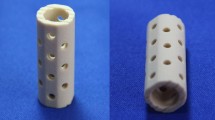Abstract
The purpose of this study was to investigate the outcome of expandable titanium cage implantation in large defects caused by acute vertebral osteomyelitis. Twenty-five patients with acute single or multilevel spondylodiscitis were treated after radical débridement and posterior instrumentation with an anterior expandable titanium cage and bone grafting. Clinical, laboratory and radiological follow-up continued for 36 months. Within the postoperative course there was no recurrence of spinal infection. The final radiological examination showed successful fusion in all cases without implant loosening or failure. At the final follow-up after 36 months the Oswestry Disability Index was 23 ± 14 and the pain visual analogue scale 2.1 ± 1.7. This study reveals healing and improved function after expandable titanium cage implantation in all patients. Prerequisites for optimal healing include radical débridement, provision of stability for weight-bearing, adequate bone grafting and correction of deformity using rigid implants.
Résumé
Le but de cette étude est d’analyser le devenir des cages titane expansibles implantées dans le cas de perte de substances osseuses aiguës vertébrales après ostéomyélite. Matériel et méthode: 25 patients présentant une spondylodiscite à un ou plusieurs niveaux ont été traités. Après mise à plat, instrumentation postérieure, mise en place d’une cage antérieure expansible et greffe, les patients ont été suivis pendant 36 mois sur le plan clinique, biologique et radiologique. Résultats: il n’y a pas eu de récidive de l’infection. Le résultat radiologique a montré une bonne fusion dans tous les cas sans descellement ou échec de l’implant. Au suivi final de 36 mois, l’index d’Oswestry est de 23 ± 14 et l’échelle douloureuse visuelle analogique est de 2.1 ± 1.7. En conclusion, cette étude permet de montrer que ces cages autorisent une cicatrisation et une amélioration de la fonction chez ces patients. Néanmoins, il est nécessaire pour obtenir ce résultat de réaliser une mise à plat, d’adapter la remise en charge, de faire une greffe également adaptée et de corriger les déformations par une instrumentation rigide.


Similar content being viewed by others
References
Aryan HE, Lu DC, Acosta FL Jr, Ames CP (2007) Corpectomy followed by the placement of instrumentation with titanium cages and recombinant human bone morphogenetic protein-2 for vertebral osteomyelitis. J Neurosurg Spine 6:23–30
Fayazi AH, Ludwig SC, Dabbah M, Bryan Butler R, Gelb DE (2004) Preliminary results of staged anterior debridement and reconstruction using titanium mesh cages in the treatment of thoracolumbar vertebral osteomyelitis. Spine J 4:388–395
Gibson MJ, Karpinski MRK, Slack RCB, Cowlishaw WA, Webb JK (1987) The penetration of antibiotics into the normal intervertebral disc. J Bone Joint Surg Br 69:784–786
Ha KY, Chung YG, Ryoo SJ (2005) Adherence and biofilm formation of Staphylococcus epidermidis and Mycobacterium tuberculosis on various spinal implants. Spine 30:38–43
Ha KY, Shin JH, Kim KW, Na KH (2007) The fate of anterior autogenous bone graft after anterior radical surgery with or without posterior instrumentation in the treatment of pyogenic lumbar spondylodiscitis. Spine 32:1856–1864
Hadjipavlou AG, Mader JT, Necessary JT, Muffoletto AJ (2000) Hematogenous pyogenic spinal infections and their surgical management. Spine 25:1668–1679
Heyde CE, Boehm H, El Saghir H, Tschoke SK, Kayser R (2006) Surgical treatment of spondylodiscitis in the cervical spine: a minimum 2-year follow-up. Eur Spine J 15:1380–1387
Klöckner C, Valencia R (2003) Sagittal alignment after anterior debridement and fusion with or without additional posterior instrumentation in the treatment of pyogenic and tuberculous spondylodiscitis. Spine 28:1036–1042
Korovessis P, Petsinis G, Koureas G, Iliopoulos P, Zacharatos S (2006) One-stage combined surgery with mesh cages for treatment of septic spondylitis. Clin Orthop Relat Res 444:51–59
Korovessis P, Petsinis G, Koureas G, Iliopoulos P, Zacharatos S (2006) Anterior surgery with insertion of titanium mesh cage and posterior instrumented fusion performed sequentially on the same day under one anesthesia for septic spondylitis of thoracolumbar spine: is the use of titanium mesh cages safe? Spine 31:1014–1019
Kuklo TR, Potter BK, Bell RS, Moquin RR, Rosner MK (2006) Single-stage treatment of pyogenic spinal infection with titanium mesh cages. J Spinal Disord Tech 19:376–382
Lerner T, Schulte T, Bullmann V, Schneider M, Hackenberg L, Liljenqvist U (2006) Anterior column reconstruction using titanium ring cages in severe vertebral osteomyelitis. Eur J Trauma 32:227–237
McGuire RA, Eismont FJ (1994) The fate of autogenous bone graft in surgically treated pyogenic vertebral osteomyelitis. J Spinal Disord 7:206–215
Ozturk C, Aydinli U, Vural R, Sehirlioglu A, Mutlu M (2007) Simultaneous versus sequential one-stage combined anterior and posterior spinal surgery for spinal infections (outcomes and complications). Int Orthop 31:363–366
Robinson Y, Reinke M, Kayser R, Ertel W, Heyde CE (2007) Postoperative multisegmental lumbar discitis treated by staged ventrodorsoventral intervention. Surg Infect (Larchmt) 8:529–534
Robinson Y, Tschöke SK, Finke T, Kayser R, Ertel W, Heyde CE (2008) Successful treatment of spondylodiscitis using titanium cages. Acta Orthop (in press)
Ruf M, Stoltze D, Merk HR, Ames M, Harms J (2007) Treatment of vertebral osteomyelitis by radical debridement and stabilization using titanium mesh cages. Spine 32:E275–E280
Shad A, Shariff S, Fairbank J, Byren I, Teddy PJMAD, Cadoux-Hudson TAD (2003) Internal fixation for osteomyelitis of cervical spine: the issue of persistence of culture positive infection around the implants. Acta Neurochir (Wien) 145:957–960
Stoltze D, Harms J (1999) Correction of posttraumatic deformities. Principles and methods (in German). Orthopade 28:731–745
Tali ET (2004) Spinal infections. Eur J Radiol 50:120–133
Tay BKB, Deckey J, Hu SS (2002) Spinal infections. J Am Acad Orthop Surg 10:188–197
Ulmar B, Richter M, Kelsch G, Cakir B, Puhl W, Huch K (2005) Distractible vertebral body replacement for the thoracic and lumbar spine. Acta Orthop Belg 71:467–471
Wlodarski KH, Galus R (2005) Histological aspects of bone fracture healing. Ortop Traumatol Rehabil 7:351–360
Author information
Authors and Affiliations
Corresponding author
Rights and permissions
About this article
Cite this article
Robinson, Y., Tschoeke, S.K., Kayser, R. et al. Reconstruction of large defects in vertebral osteomyelitis with expandable titanium cages. International Orthopaedics (SICOT) 33, 745–749 (2009). https://doi.org/10.1007/s00264-008-0567-2
Received:
Revised:
Accepted:
Published:
Issue Date:
DOI: https://doi.org/10.1007/s00264-008-0567-2




